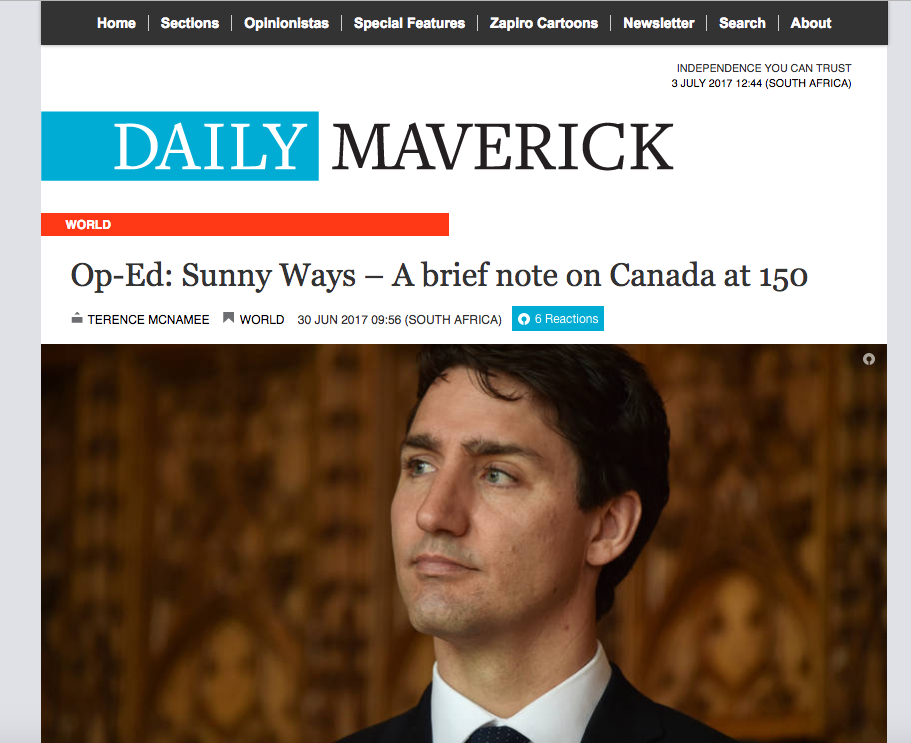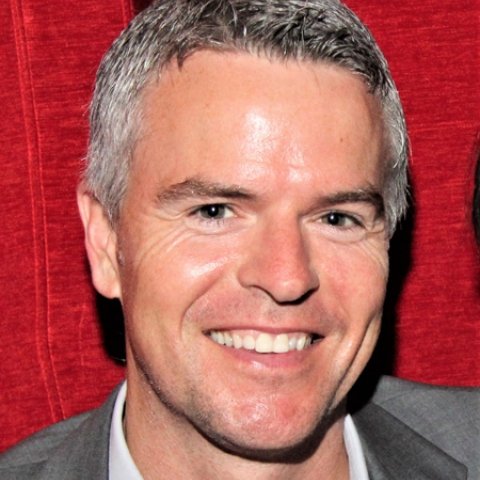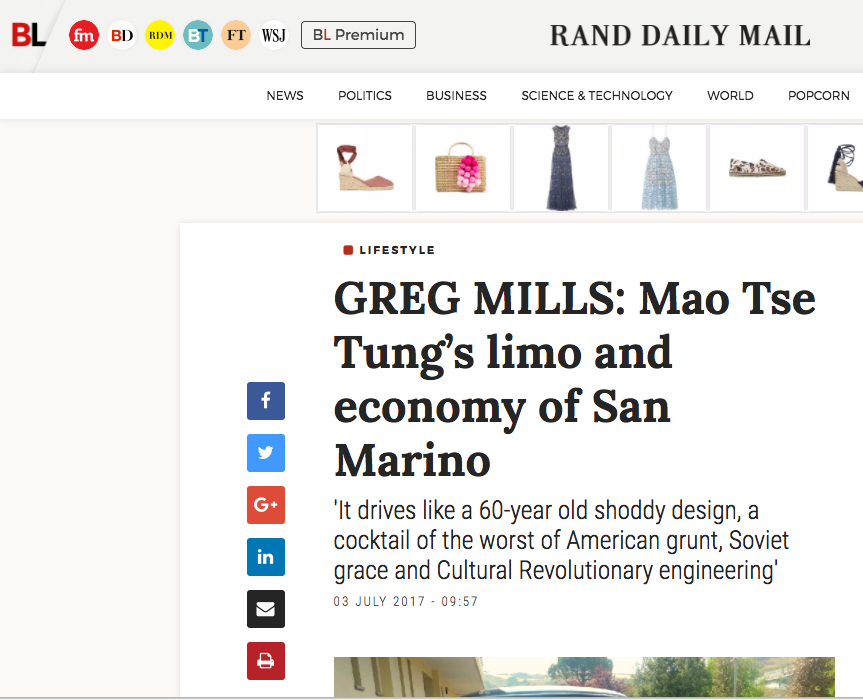News
Daily Maverick: Sunny Ways — A brief note on Canada at 150
A sesquicentennial seems an apt time to make the case for boring.

Canada turns 150 tomorrow. As sesquicentennials go, this one is unlikely to stir the world’s imagination. But Canadians won’t lose sleep over that. We are used to resting lightly on the global consciousness. Especially during the years BJ (Before Justin).
Inconspicuousness was once our métier. Canada existed in a kind of netherworld: somewhere vaguely cold and boring, similar to but nicer than the United States. Better known than say Togo or Suriname, sure. But better known than broadly comparable societies like New Zealand, seven times less populous and eight times smaller economically than Canada? Not likely. And Australia? Not a chance.
That was certainly true of South Africans. A few of the more politically-minded knew Canada as a strong foe of apartheid. Fewer still that South Africa’s Constitution and Bill of Rights drew heavily on the Canadian Charter of Rights and Freedoms. If you knew a lot about Canada, odds are that you had emigration on your mind.
The election of Justin – our dreamy Prime Minister, Justin Trudeau – in 2015 changed the narrative. International media couldn’t get enough of him, and still can’t. Young, strikingly progressive and gregarious almost to a fault – a near perfect antithesis of his charmless predecessor – Trudeau injected cool into the nation’s brand. He’s given Canada a new face and more global airtime. The tattoos and yoga poses added to the fever of newness.
This was a chimera, of course.
Rather than breaking from Canada’s past, Trudeau has affirmed it. His fresh persona belies a consistent thread of ideas woven ever-tightly together into government policy over half a century. Administrations of different political hues have come and gone in Ottawa but substantive policy shifts have been rare.
If you thought Canada was dull before Justin, you may be disappointed. What’s new is not Canada itself but the world around it. If anyone needed a reminder: President Donald Trump!
A sesquicentennial seems an apt time to make the case for boring.
A clause found in several British colonial acts, “Peace, Order and Good government” resonated so enduringly in Canada that it became something of a tripartite motto for the country. Hardly the stuff of Henry V at Agincourt, but it has delivered welfare, education and health care systems envied worldwide. Boring helped Canada to blunt the impact of the global financial crisis through prudent regulation and supervision. No Canadian banks had to be bailed out or were at risk of failing.
What is not boring are Canada’s policies on social cohesion and nation building. In fact, they are decidedly radical, and might just help save the West from the ravages of populism.
To understand them, we need to start at the beginning, 150 years ago, at independence in 1867. The signing of the British North America Act brought the French settlers into what was then lower Canada into political union – or confederation – with English settlers in “upper Canada”. The French-speaking minority had full rights but were generally treated like second-class citizens. The incipient Canadian nationalism of the 19th century was imperially oriented and emphatically British.
Nearly a century and two world wars would pass before Canada fully emerged out of the imperial shadow, complete with its own founding myths and symbols. The national flag – the Maple Leaf – was adopted just two years before Canada’s centenary; O Canada, the national anthem, not until 1980. The country’s constitution was patriated from Britain in 1982. Bilingualism, a central pillar of the one-nation vision of Canada, was only implemented in earnest across the country thereafter.
Not so long ago Canada’s linguistic fault line – buttressed by ethnic and religious differences – threatened to pull the country apart. Such were the political tensions it was once said that the difference between Americans and Canadians is that while Americans look back to their Civil War, Canadians look forward to theirs.
Careful policy making and adroit leadership on all sides have steered Canada well clear of that outcome. The principal stresses on Canada’s French-English fault line have lost much of their potency in recent decades. Some differences may never be bridged but the divide between them has never been thinner.
Canada is rare among multinational states in not portraying itself in terms of the majority population. It is rarer still, if not unique, in merging bilingualism with multiculturalism.
Canada is expressed in law (the 1985 Canadian Multiculturalism Act) as a multicultural mosaic under the direction of a decentralised federal state. Successive governments have consistently maintained that in an ethnically diverse country heavily influenced by and dependent on immigration from all parts of the world, an official policy of multiculturalism promotes the national interest by breaking down social and cultural barriers. Multiculturalism is thus enshrined as a fundamental characteristic of Canadian identity and heritage.
That identity is malleable by design. Accommodating Canada’s burgeoning diversity made political sense since new immigrants constituted an increasingly powerful bloc of voters. And it also made practical sense. Integrating peoples from different backgrounds would be harder if they had to conform to a rigid notion of what it means to be Canadian.
Here is an excerpt from a famous speech by Trudeau explaining why Canada chose a mosaic over a melting pot:
“A society which emphasises uniformity is one which creates intolerance and hate. A society which eulogises the ‘average citizen’ is one which breeds mediocrity. What the world should be seeking are not concepts of uniformity… but human values: compassion, love and understanding.”
This speech was delivered the year Justin was born, in 1971, by his father Pierre, then three years into a premiership that would last 16. Pierre Trudeau was addressing the Ukrainian-Canadian Congress. Ukrainian immigrants to Canada faced considerable discrimination in the first half of the twentieth century. They were singled out by nativist groups due to their large numbers, political activism and different customs.
As Canada became more pluralistic in character and outlook, ill-treatment of Ukrainians and other minorities became increasingly rare.

Pierre Trudeau – considered the father of modern Canada by some (myself included) – first championed the idea that diversity strengthens, not weakens national identity. Multiple forms of belonging and attachment to a state are not easy to accommodate. Various decentralised institutions and asymmetric structures are required. For the most part, Canada has made them work.
During the past 18 months, more than 40,000 Syrian refugees have been settled in Canada. (The UK, by comparison, has settled roughly 6,000 over the same period.) There is always a risk that dramatic spikes in immigration will destabilise communities. Canada’s progressive approach insulated itself from many of the risks. A unique refugee sponsorship programme gave ordinary Canadians a direct stake in the lives and resettlement of Syrian families. It has been successful in large part because the new arrivals are not perceived as diminishing but reinforcing who we are.
That might sound mawkish and corny were it not so effective in countering the scourge of populism wreaking havoc in political systems across the West. Writing in The New York Times, Amanda Taub observed that Canada has the key ingredients for getting infected by the scourge: ‘a white ethnic majority that is losing its demographic dominance. A sharp rise in immigration that is changing culture and communities. News media and political personalities who bet big on white backlash.’ Yet Canada’s liberal democratic order remains solidly intact.
Taub puts that down to a bit of luck and favourable geography but mostly politics. Canada recognises diversity without polarising across ethnic or religious lines. For right-wing populism to thrive you need a politics of “us-versus-them”. Immigrants are often cast as “them”. When immigration is perceived within society as a net benefit, as in Canada, a major source of fuel for populism is cut off.
All this makes Canada seem preternaturally good. Yet there are plenty of scars underneath its squeaky-clean exterior.
Canada is still dealing with the legacy of ruinous government policies – forced assimilation, isolation from culture and family – towards the country’s First Nations, its aboriginal peoples, for whom the idea of a sesquicentennial must seem laughable. They’ve lived in the territory now called Canada for more than 10,000 years.
This vast territory, teeming with resources, is not being looked after nearly as well as it should be. A report from the Conference Board of Canada released last year ranked Canada 14th among 16 peer countries when it comes to environmental performance, with only the United States and Australia doing worse. This from a leading advocate of green energy and multilateral approaches to climate change.
And not so long ago Canada had its own mini-Trump, Rob Ford. He was the mayor of Canada’s largest city, Toronto, until 2014. Colleagues described him as misogynistic, bigoted, homophobic and crude – on a good day. He also drank too much and smoked crack cocaine.
Justin Trudeau he was not.
The younger Trudeau is partial to a phrase used by one of his predecessors, Wilfred Laurier, to help resolve a major crisis between different religious-linguistic communities at the turn of the 20th century. The term is "sunny ways” and Laurier’s efforts were successful. Trudeau used it at the beginning of his victory speech on becoming Canada’s 23rd Prime Minister. “Sunny ways, my friends. Sunny ways.” He was referring to what positive politics can achieve. Not a bad description of Canada at 150 either.


